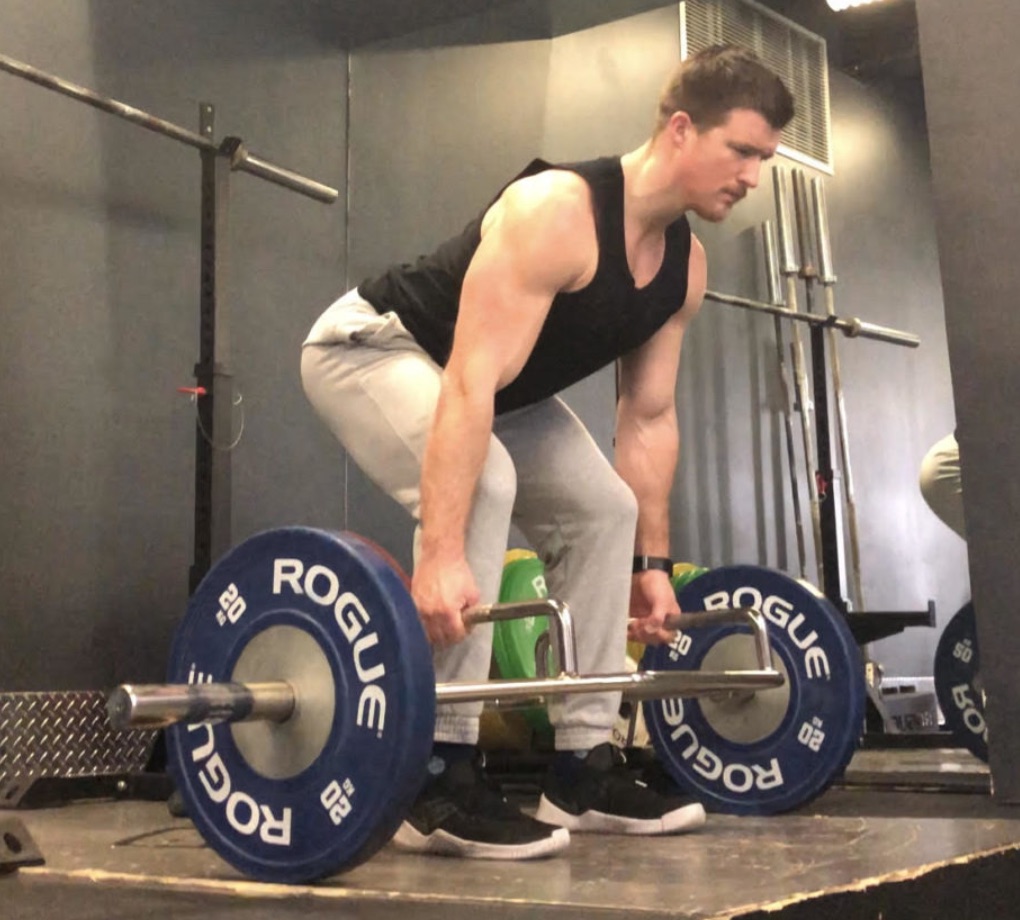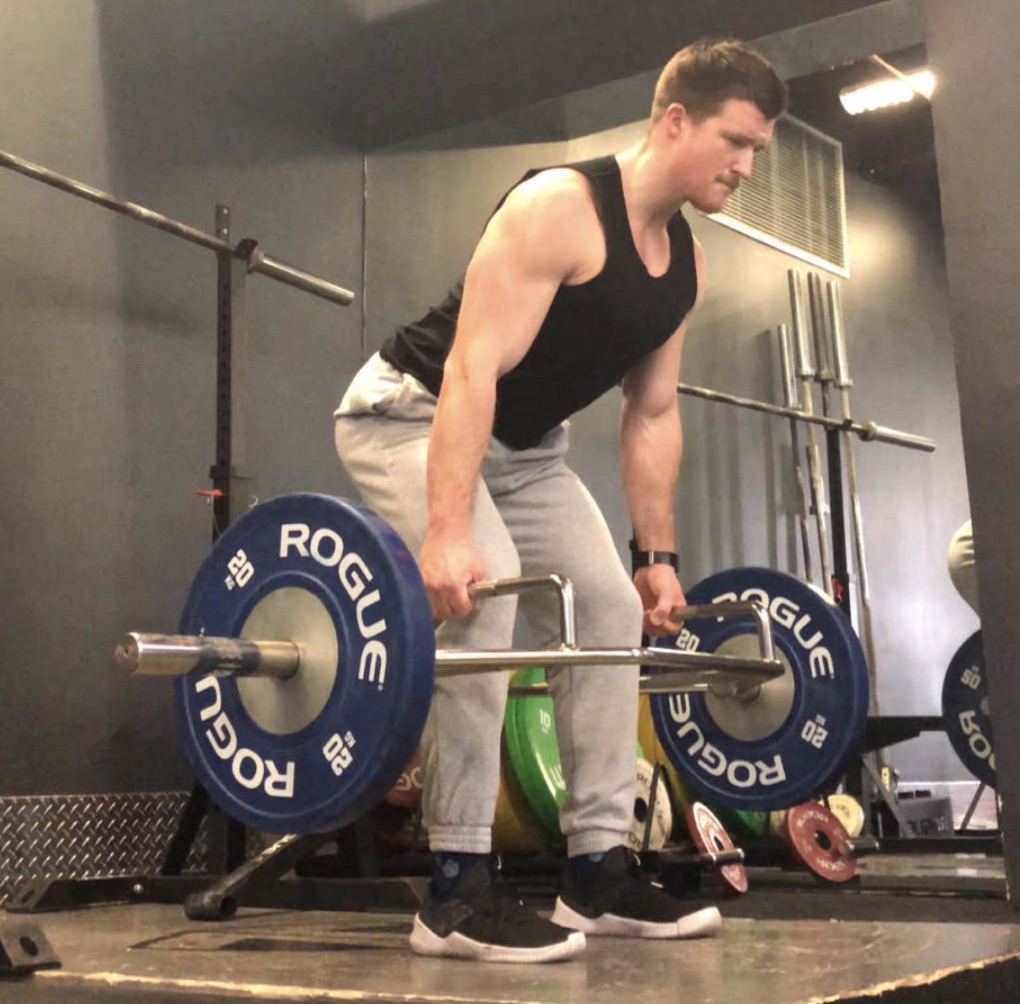The trap bar deadlift is a strength movement that has a wide application to sport athletes, lifters, and general fitness. In this article we will dig deeper into four benefits of the trap bar deadlift and why these benefits can impact athlete development, strength training, and general fitness goals.
How-To Trap Bar Deadlift

1.
The Setup
Start by assuming a hip width stance with the toes pointed forward (in line with the knees).
The stance width will vary, however generally speaking, the width should allow for the athlete to have the shins perpendicular to the floor with the back flat and shoulders directly above the bar.
Coach’s Tip: Think pushing the hips back and keeping the shins vertical (however they can be slightly forward if you are allowing the hips to drop (see training modifications in next section).

2.
Load the Pull
Squeeze the bar as you pull the shoulderblades down the back, allowing the chest and shoulders to get pulled upwards.
Without lifting the bar, find full pressure in the foot as you start to load the pull.
Coach’s Tip: Flex the triceps and pull the back taunt.

3.
Push Through the Floor
Push downwards into the floor with the legs, and keep the chest up.
Focus on feeling the knees and hips extending as you drive your feet into the ground.
Coach’s Tip: Push through the floor (with the legs).

4.
Stand Strong
Assume a vertical position with the pelvis neutral (no lumbar extension/flexion) and the upper back set.
The shoulderblades should be down the back, with the load being diserpse between the upper back, traps, glutes legs and grip.
Coach’s Tip: Squeeze the glutes at the top.
4 Benefits of the Trap Bar Deadlift
Below are four (4) main benefits of the trap bar deadlift athletes, coaches, and trainers can expect when integrating this hinging movement into training programs.
1. Great for Beginners
The trap bar deadlift is a great exercise for all lifters, however can be used with beginners to help fast track them towards increasing muscle growth, pulling strength, and understanding proper hinging mechanics. Below are a few specific reasons why the trap bar deadlift is great for beginners (and advanced lifters alike).
Minimizes Hyperextension
The trap bar deadlift minimizes excessive hyperextension (overpulling) that can occur during a conventional or sumo deadlift, primary due to the inability to use the barbell as a counterbalance. This can be helpful for lifters to learn what it means by a neutral position and to stay active under loads.
Shorter Range of Motion
The trap bar deadlift often has handles that are raised, which shortens the degree of flexion at the hips and knees. In doing so, the flexibility and mobility demands at the hips and hamstrings are less than the conventional deadlift.
Often, many beginners (and taller individuals) will struggle with assuming a flat back where the hips are flexed at deep angles (necessary during conventional deadlifts). Coach and trainers can use trap bar deadlifts to increase back and hip strength and then progress the lifter into deeper range of motion.
Less Potential Strain on the Lower Back
While deadlifting in general can involve stress and strain on the lower back, it is important to recognize the trap bar deadlift benefits for many beginners. The trap bar deadlift, while still used as a hinging movement, generally produces less stress on the lower back than conventional deadlifts, making it a good variation to develop strength yet allow the lower back to recovery.
2. High Transfer to Sports
Olympic Weightlifting
Olympic weightlifters typically train the clean pull/clean deadlift, a movement that places the lifter in a more upright pulling position (when compared to the standard conventional deadlift). Like the clean deadlift, the trap bar deadlift can be used to increase leg and back strength yet minimize lower back stress. Trap bar deadlifts can also be done with lower hip positions to target the quadriceps and glutes, similar to what is needed in the clean pull.

Powerlifting and Strongman
While powerlifting involves either a conventional or sumo style deadlift, coaches can use the trap bar deadlift to diversify pulling strength and minimize some strain on the lower back (if this is a goal). For strongman athletes, pulling from a variety of positions can be beneficial during competitions and/or for general strength development (frame carries and farmer carries).
Formal Athletics
Formal sport athletes can benefit from performing trap bar deadlifts due to their applications to jumping, athletic stances, etc. Coaches can also use trap bar deadlifts to minimize lower back strain/improve overall safety with newer athletes and athletes who struggle with proper positioning in the conventional deadlift.
3. Can Potentially Minimize Injury (vs Conventional)
While exercising in general has an inherent risk of injury, trap bar deadlifting can help coaches take precautionary measures with taller and/or beginner lifters as if limits range of motion and lumbar stress (due to a more vertical back angle).
Limited Lumbar Extension
During the conventional and sumo deadlift, some lifters go into hyperextension with the lumbar spine rather than using the glutes to finish the lift. When using a straight bar the lifter is able to use the bar as a counterbalance and can run the risk of hyperextending the spine at the top of the lift. This should be addressed and can often be done so by giving the athlete physical and verbal feedback.
No Mixed Grip
Mixed grips is a common grip style that can help lifters lift heavier loads. Over time, this may lead to some muscular imbalances if a program does not add additional corrective movements to enhance unilateral balance and symmetry.
Slightly Less Lumbar Strain
Generally speaking, the trap bar deadlift is less hip dominant than a conventional deadlift, as the lifter is in a more upright position (it’s important to note you can still make the trap bar deadlift highly hip dominant). Increasing the vertical positioning of the torso helps to limit spinal stress.
4. Diversify Pulling Strength
To develop well-rounded pulling performance, a lifter can integrate a variety of exercises to diversify strength and muscular development.
While a lifter should train consistently with their primary deadlifting stance/technique, integrating variety into training can help increase muscle growth and maximize injury prevention (and minimize overuse)
More Deadlift Articles
Take a look at the below deadlift guides to build strength, improve muscle hypertrophy, and smash PRs!
Feature Photo By Arturs Mikelsons / Shutterstock